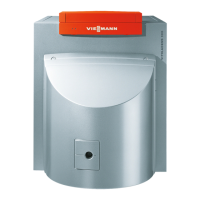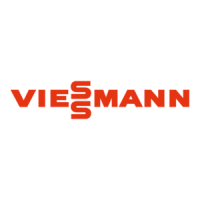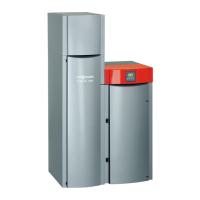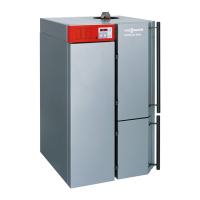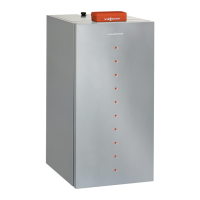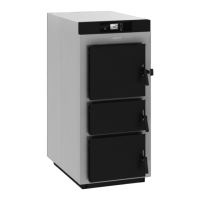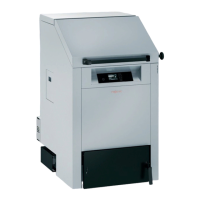Why does my Viessmann Boiler display show 'E'?
- CcandacenelsonJul 27, 2025
When a fault in the burner control unit occurs in Viessmann Boiler, the display will show 'E'.




Why does my Viessmann Boiler display show 'E'?
When a fault in the burner control unit occurs in Viessmann Boiler, the display will show 'E'.
Why does the fault message reappear on my Viessmann Vitoladens 300-C Boiler?
If an acknowledged fault in Viessmann Boiler isn't resolved, the fault message will reappear the next day at 07:00 h.
Explains symbols like Danger and Please note for safety and environmental concerns.
Provides safety guidelines for performing work on the heating system.
Safety procedures to follow if flue gas is detected.
Safety measures for water escapes, addressing electric shock and scalding risks.
Safety requirements for flue systems and ensuring adequate combustion air supply.
Safety warning about simultaneous operation of extractors and boilers causing flue gas reversal.
General procedures and safety precautions for installation, maintenance, and cleaning.
Details on mounting and connecting the safety equipment block and its components.
Guides for connecting condensate drains and neutralising systems.
Instructions for connecting the flue gas system in open or room-sealed modes.
Steps for installing the single-line fuel oil supply system, including filter recommendations.
General information and safety notes for making electrical connections.
Details on 230V power supply connections and safety precautions.
Guides on filling the heating system with water and precautions for fill water quality.
Procedures for venting air from the boiler.
Procedures for venting air from the entire heating system.
Describes the burner's operational sequence and potential faults.
Detailed procedures for cleaning the biferral heating surface.
Procedures for cleaning the stainless steel heat exchanger.
Final steps for flushing the heat exchanger and reinserting the combustion chamber.
Detailed steps for cleaning the burner, including removing the cover and cleaning components.
Procedures for replacing the nozzle and checking/adjusting ignition electrodes.
Guides for cleaning or replacing the oil pump filter.
Guides for adjusting standard burner settings, including heat input and oil pressure.
Procedures for adjusting oil pressure and checking vacuum levels for optimal burner performance.
Guides for adjusting the air volume or static burner pressure for efficient combustion.
Explains how heating curves relate outside temperature to boiler water temperature.
Guides on adjusting the slope and level of heating curves for optimal performance.
How to call up and reset the "Service" display for maintenance reminders.
Instructions on how to enter the service level and access diagnostic data.
Procedures for resetting operating data and performing a brief scan of system information.
Explains how faults are displayed and how to retrieve fault codes from memory.
Lists fault codes, their causes, and recommended measures for diagnosis.
Guides for testing outside, boiler water, and cylinder temperature sensors.
Procedures for checking the flue gas temperature sensor and the temperature limiter.
Guides for changing mixer motor rotation direction and checking flow temperature sensors.
Explains operating program changeover, external blocking, external demand, and output functions.
Details on configuring operating program changeover and the effects of external blocking.
Comprehensive technical data, output ratings, dimensions, and electrical characteristics of the boiler.
Explains symbols like Danger and Please note for safety and environmental concerns.
Provides safety guidelines for performing work on the heating system.
Safety procedures to follow if flue gas is detected.
Safety measures for water escapes, addressing electric shock and scalding risks.
Safety requirements for flue systems and ensuring adequate combustion air supply.
Safety warning about simultaneous operation of extractors and boilers causing flue gas reversal.
General procedures and safety precautions for installation, maintenance, and cleaning.
Details on mounting and connecting the safety equipment block and its components.
Guides for connecting condensate drains and neutralising systems.
Instructions for connecting the flue gas system in open or room-sealed modes.
Steps for installing the single-line fuel oil supply system, including filter recommendations.
General information and safety notes for making electrical connections.
Details on 230V power supply connections and safety precautions.
Guides on filling the heating system with water and precautions for fill water quality.
Procedures for venting air from the boiler.
Procedures for venting air from the entire heating system.
Describes the burner's operational sequence and potential faults.
Detailed procedures for cleaning the biferral heating surface.
Procedures for cleaning the stainless steel heat exchanger.
Final steps for flushing the heat exchanger and reinserting the combustion chamber.
Detailed steps for cleaning the burner, including removing the cover and cleaning components.
Procedures for replacing the nozzle and checking/adjusting ignition electrodes.
Guides for cleaning or replacing the oil pump filter.
Guides for adjusting standard burner settings, including heat input and oil pressure.
Procedures for adjusting oil pressure and checking vacuum levels for optimal burner performance.
Guides for adjusting the air volume or static burner pressure for efficient combustion.
Explains how heating curves relate outside temperature to boiler water temperature.
Guides on adjusting the slope and level of heating curves for optimal performance.
How to call up and reset the "Service" display for maintenance reminders.
Instructions on how to enter the service level and access diagnostic data.
Procedures for resetting operating data and performing a brief scan of system information.
Explains how faults are displayed and how to retrieve fault codes from memory.
Lists fault codes, their causes, and recommended measures for diagnosis.
Guides for testing outside, boiler water, and cylinder temperature sensors.
Procedures for checking the flue gas temperature sensor and the temperature limiter.
Guides for changing mixer motor rotation direction and checking flow temperature sensors.
Explains operating program changeover, external blocking, external demand, and output functions.
Details on configuring operating program changeover and the effects of external blocking.
Comprehensive technical data, output ratings, dimensions, and electrical characteristics of the boiler.
| Type | Condensing boiler |
|---|---|
| Fuel Type | Oil |
| Control | Vitotronic control unit |
| Max. Operating Pressure | 3 bar |
| Max. Flow Temperature | 85 °C |
| Efficiency | 98% |
| Installation | Floor-standing |
| Modulation Range | 1:3 |
| NOx Emissions | Class 5 |

